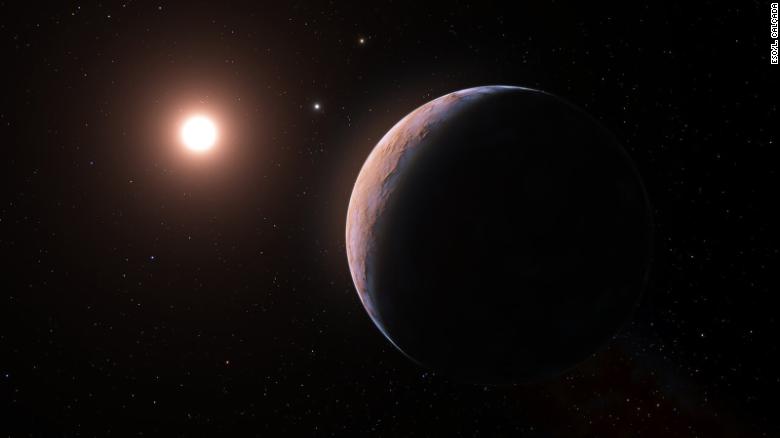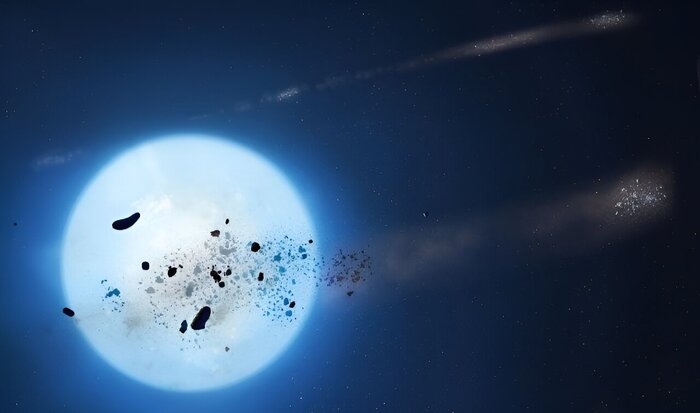An artist's rendering shows a detailed view of Proxima d, a planet candidate recently found in orbit around the red dwarf star Proxima Centauri, the closest star to our sun.
(CNN) --
We may have a new planetary neighbor orbiting just four light-years away.
Astronomers have detected evidence of a third planet orbiting Proxima Centauri, our sun's closest stellar neighbor, 40.2 billion kilometers away.
One light year, the distance that light travels in one year in a vacuum, is equal to about 9.46 trillion kilometers.
With a mass about a quarter of that of Earth, the rocky object is one of the lightest exoplanets ever found.
A study detailing the discovery published Thursday in the journal
Astronomy & Astrophysics
.
The small, dim red dwarf star is only one-eighth the mass of the Sun and already hosts a confirmed Earth-size planet and possibly a second, more distant planet candidate.
advertising
Possible conditions for life
This latest detected planet, called Proxima d, completes one orbit around the star every five Earth days.
It is only about 4 million kilometers from the star, which is less than a tenth of the distance between Mercury and the Sun in our solar system.
Being the closest planet to the Sun, Mercury completes an orbit around it every 88 days.
The first planet found in the system, Proxima b, was confirmed in 2020. It is about the size of Earth and orbits the star every 11 days.
It exists within the habitable zone, or the distance from a star where conditions are right for liquid water, one of the key ingredients for life as we know it, to exist on the planet's surface.
As for its neighbors, Proxima d is too close to the star to be in the habitable zone, and Proxima c, which takes about five years to orbit the star, is too far away.
"The discovery shows that our closest stellar neighbor seems to be teeming with new and interesting worlds, within the scope of further study and future exploration," said study lead author João Faria, a researcher at the Institute of Astrophysics and Space Sciences of Portugal, it's a statement.
Astronomers found Proxima d while using the European Southern Observatory's Very Large Telescope in Chile.
The observatory's telescopes and instruments had been used to find and confirm past planet discoveries in the Proxima Centauri system.
This illustration shows a wider view of Proxima d (right) as it orbits Proxima Centauri (left).
During recent follow-up observations of the system, astronomers detected a faint signal from an object in a fast orbit around the star.
Further observations were made using the Echelle High-Sensitivity Spectrograph for Rocky Exoplanets and the Steady Spectroscopic Observations instrument, known as ESPRESSO, on the Very Large Telescope.
The data suggested that a possible planet was present and that its gravitational pull was pulling on the star, rather than changes in the star.
"After obtaining new observations, we were able to confirm this signal as a new planet candidate," Faria said.
"I was excited by the challenge of detecting such a small signal and, in doing so, discovering an exoplanet so close to Earth."
Future observations of the planet candidate could confirm that Proxima d is, in fact, the third known world orbiting this star.
A method for identifying Earth-like planets
Exoplanets have been found around Proxima Centauri using the indirect radial velocity method, when gravity from an orbiting object pulls on a star and causes it to wobble slightly, rather than observing dips in starlight as planets pass by. facing the stars, called the transit method.
But this is the first time the radial velocity method has been used to find such a light planet.
"This achievement is extremely important," Pedro Figueira, ESPRESSO instrument scientist, said in a statement.
"It shows that the radial velocity technique has the potential to reveal a population of light planets, like our own, that are expected to be the most abundant in our galaxy and that can potentially support life as we know it."
The researchers believe that future observations could still reveal more details, and even additional planets, within the system.
"This result clearly shows what ESPRESSO is capable of and makes me wonder what it may find in the future," said Faria.
Planet





/cloudfront-eu-central-1.images.arcpublishing.com/prisa/TQ73US57UFGWTIXR7C3BS2OTIA.jpg)

/cloudfront-eu-central-1.images.arcpublishing.com/prisa/PA5TT2ZCYBDNLEAREMUPESRVOM.jpg)



/cloudfront-eu-central-1.images.arcpublishing.com/prisa/KMEYMJKESBAZBE4MRBAM4TGHIQ.jpg)


